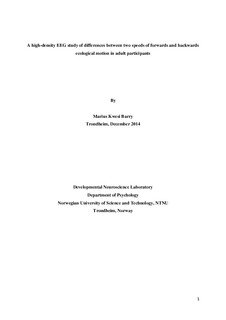| dc.description.abstract | A high-density EEG study was carried out to investigate the evoked and induced activity caused by an optic flow stimulus simulating ego-motion. The optic flow stimulus consisted of a road with poles on both sides and movement was simulated both forwards and backwards at two different speeds, with a static condition in between movement conditions. The aim was to analyze the N2 component of the visually evoked potentials and the induced oscillatory activity caused by the stimulus, in the occipital and parietal regions of the cortex. N2 peak latencies in parietal channels P4, PO4, POz and P2 in the low speed motion conditions were significantly lower than in the high speed motion conditions. This increase in N2 peak latencies was thought to reflect that the processing of simulated ego-motion at low speeds is easier than simulated ego-motion at higher speeds. The analysis of the N2 peak amplitudes showed significantly larger amplitudes for the forward motion conditions than for the backwards motion conditions, indicating an activation of a larger pool of neurons for forwards motion, or an increased sensitivity for forwards motion. The time-frequency analysis showed a desynchronization in the alpha frequency band in channel PM in response to all motion conditions. This was thought to reflect the processing of visual information, or a heightened attentive or anticipatory state. The alpha band synchronizations found in the static conditions was interpreted as the brain being in an idling or resting state. A significant desynchronization in the beta frequency band was also found, thought to reflect communication between brain hemispheres. These results taken together could imply that the speed at which we process information regarding ego-motion is greatly influenced by the velocity of our movement through the environment, and not so much by whether the movement is forwards or backwards. | nb_NO |
